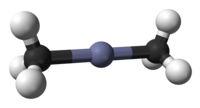Dimethylzinc
 |
|
| Names | |
|---|---|
|
IUPAC name
dimethylzinc
|
|
| Identifiers | |
|
544-97-8 |
|
| 3D model (Jmol) | Interactive image |
| ChEBI |
CHEBI:51497 |
| ChemSpider |
10254473 |
| ECHA InfoCard | 100.008.077 |
| PubChem | 11010 |
|
|
|
|
| Properties | |
| Zn(CH3)2 | |
| Molar mass | 95.478 g/mol |
| Melting point | −42 °C (−44 °F; 231 K) |
| Boiling point | 46 °C (115 °F; 319 K) |
|
Except where otherwise noted, data are given for materials in their standard state (at 25 °C [77 °F], 100 kPa).
|
|
|
|
|
| Infobox references | |
Dimethylzinc, also known as Zinc methyl, DMZ, or DMZn is a colorless mobile liquid Zn(CH3)2, formed by the action of methyl iodide on zinc at elevated temperature or on zinc sodium alloy.
The sodium assists the reaction of the zinc with the methyl iodide. Zinc iodide is formed as a byproduct.
It has a disagreeable odor, and is pyrophoric. It has been of great importance in the synthesis of organic compounds. It is soluble in alkanes and often sold as a solution in hexanes. It belongs to the large series of similar compounds such as diethylzinc.
This substance was first prepared by Edward Frankland during his work with Robert Bunsen in 1849 at the University of Marburg. After heating a mixture of zinc and methyl iodide in an airtight vessel, a flame burst out when the seal was broken. In the laboratory, this synthesis method remains unchanged today, except that copper or copper compounds are used to activate the zinc.
Dimethyl zinc was used for a long time to introduce methyl groups into organic molecules or to synthesize organometallic compounds containing methyl groups. Grignard reagents, (organo-magnesium compounds), which are easier to handle and less flammable replaced organo-zinc compounds in most laboratory syntheses. Due to differences in reactivity (as well as in reaction by-products) between organo-zinc compounds and Grignard reagents, organo-zinc compounds may be preferred in some syntheses. Its high vapor pressure has led to extensive uses in metalorganic chemical vapor deposition (MOCVD) for the preparation of wide band gap II–VI semiconducting films (e.g. ZnO, ZnS, ZnSe, ZnTe) and as p-dopant precursors for III–V semiconductors (e.g. GaAs, InP, AlxGa1-xAs), which have many electronic and photonic applications.
...
Wikipedia
